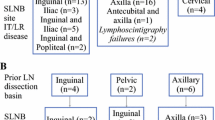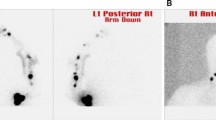Abstract
Background and objective
The Multicenter Selective Lymphadenectomy Trial (MSLT-I) demonstrated that the sentinel node (SN) status in cutaneous melanoma affects prognosis and that completion lymphadenectomy in SN-positive patients may improve survival. Our objective was to evaluate sentinel lymph node biopsy (SLNB) in two regional hospitals in the Netherlands.
Methods
Patients with localized melanoma were planned for wide excision and SLNB. Completion lymphadenectomy was recommended for positive SN status. Data were compared with the MSLT-I.
Results
A median of 2 (1–7) SNs were identified in 305 patients and complications occurred in 11%. Fifty-four patients (18%) demonstrated SN metastases and 45 underwent completion lymphadenectomy (20% additional metastases). Six patients with initially negative SN developed lymph node metastases (sensitivity 90%). Overall disease-free survival was 83% (SN-negative 91% vs. SN-positive 41%; p < 0.001) and melanoma-specific survival was 93% (SN-negative 97% vs. SN-positive 62%; p < 0.001). Multivariate regression analysis revealed the SN status to be the most significant predictor for recurrence and melanoma-related death.
Conclusion
Our results of SLNB are comparable to data from high-volume centers participating in MSLT-I. From a patient perspective, the false-negative SN rate of 10% and complication rate of 11% should be weighed against being informed about prognosis and having a possible therapeutic benefit from completion lymphadenectomy.

Similar content being viewed by others
Abbreviations
- SN:
-
Sentinel node
- SLNB:
-
Sentinel lymph node biopsy
- LND:
-
Lymph node dissection
- DFS:
-
Disease-free survival
- DSS:
-
Disease-specific survival
References
Richtig E, Gerger A, Berghold A et al (2007) Natural history of invasive cutaneous melanoma in Styria, Austria 2001–2003. J Dtsch Dermatol Ges 5(4):293–299
Balch CM, Soong SJ, Gershenwald JE et al (2001) Prognostic factors analysis of 17,600 melanoma patients: validation of the American Joint Committee on Cancer melanoma staging system. J Clin Oncol 19(16):3622–3634
Balch CM, Buzaid AC, Soong SJ et al (2003) New TNM melanoma staging system: linking biology and natural history to clinical outcomes. Semin Surg Oncol 21(1):43–52
Drepper H, Kohler CO, Bastian B et al (1993) Benefit of elective lymph node dissection in subgroups of melanoma patients. Results of a multicenter study of 3616 patients. Cancer 72(3):741–749
Baas PC, Schraffordt KH, Hoekstra HJ et al (1992) Groin dissection in the treatment of lower-extremity melanoma. Short-term and long-term morbidity. Arch Surg 127(3):281–286
Cascinelli N, Morabito A, Santinami M et al (1998) Immediate or delayed dissection of regional nodes in patients with melanoma of the trunk: a randomised trial. WHO Melanoma Programme. Lancet 351(9105):793–796
Balch CM, Soong S, Ross MI et al (2000) Long-term results of a multi-institutional randomized trial comparing prognostic factors and surgical results for intermediate thickness melanomas (1.0 to 4.0 mm). Intergroup Melanoma Surgical Trial. Ann Surg Oncol 7(2):87–97
Morton DL, Wen DR, Wong JH et al (1992) Technical details of intraoperative lymphatic mapping for early stage melanoma. Arch Surg 127(4):392–399
Statius Muller MG, van Leeuwen PA, de Lange-De Klerk ES et al (2001) The sentinel lymph node status is an important factor for predicting clinical outcome in patients with stage I or II cutaneous melanoma. Cancer 91(12):2401–2408
Thompson JF, McCarthy WH, Bosch CM et al (1995) Sentinel lymph node status as an indicator of the presence of metastatic melanoma in regional lymph nodes. Melanoma Res 5(4):255–260
van der Veen H, Hoekstra OS, Paul MA et al (1994) Gamma probe-guided sentinel node biopsy to select patients with melanoma for lymphadenectomy. Br J Surg 81(12):1769–1770
McMasters KM, Reintgen DS, Ross MI et al (2001) Sentinel lymph node biopsy for melanoma: controversy despite widespread agreement. J Clin Oncol 19(11):2851–2855
Mohrle M, Schippert W, Rassner G et al (2004) Is sentinel lymph node biopsy of therapeutic relevance for melanoma? Dermatology 209(1):5–13
Thomas JM (2007) Correspondence to the editor. Sentinel-node biopsy in melanoma. N Engl J Med 356(4):418–421
Estourgie SH, Nieweg OE, Kroon BB (2004) High incidence of in-transit metastases after sentinel node biopsy in patients with melanoma. Br J Surg 91(10):1370–1371
Thomas JM, Clark MA (2004) Selective lymphadenectomy in sentinel node-positive patients may increase the risk of local/in-transit recurrence in malignant melanoma. Eur J Surg Oncol 30(6):686–691
Morton DL, Thompson JF, Cochran AJ et al (2006) Sentinel-node biopsy or nodal observation in melanoma. N Engl J Med 355(13):1307–1317
Balch CM, Soong SJ, Bartolucci AA et al (1996) Efficacy of an elective regional lymph node dissection of 1 to 4 mm thick melanomas for patients 60 years of age and younger. Ann Surg 224(3):255–263
Morton DL, Thompson JF, Essner R et al (1999) Validation of the accuracy of intraoperative lymphatic mapping and sentinel lymphadenectomy for early-stage melanoma: a multicenter trial. Multicenter Selective Lymphadenectomy Trial Group. Ann Surg 230(4):453–463
Centraal Beleidsorgaan voor de intercollegiale toetsing. http://www.cbo.nl/Downloads/322/rl_melanoomvdhuid_2005.pdf. Accessed 25 Aug 2008
Estourgie SH, Nieweg OE, Valdes Olmos RA et al (2003) Review and evaluation of sentinel node procedures in 250 melanoma patients with a median follow-up of 6 years. Ann Surg Oncol 10(6):681–688
Morton DL, Cochran AJ, Thompson JF et al (2005) Sentinel node biopsy for early-stage melanoma: accuracy and morbidity in MSLT-I, an international multicenter trial. Ann Surg 242(3):302–311
van Poll D, Thompson JF, Colman MH et al (2005) A sentinel node biopsy does not increase the incidence of in-transit metastasis in patients with primary cutaneous melanoma. Ann Surg Oncol 12(8):597–608
Kang JC, Wanek LA, Essner R et al (2005) Sentinel lymphadenectomy does not increase the incidence of in-transit metastases in primary melanoma. J Clin Oncol 23(21):4764–4770
Molenkamp BG, Statius Muller MG, Vuylsteke RJ et al (2005) Selective lymphadenectomy in sentinel node-positive patients may increase the risk of local/in-transit recurrence in malignant melanoma. Eur J Surg Oncol 31(2):211–212
Cascinelli N, Belli F, Santinami M et al (2000) Sentinel lymph node biopsy in cutaneous melanoma: the WHO Melanoma Program experience. Ann Surg Oncol 7(6):469–474
Ferrone CR, Panageas KS, Busam K et al (2002) Multivariate prognostic model for patients with thick cutaneous melanoma: importance of sentinel lymph node status. Ann Surg Oncol 9(7):637–645
Gershenwald JE, Thompson W, Mansfield PF et al (1999) Multi-institutional melanoma lymphatic mapping experience: the prognostic value of sentinel lymph node status in 612 stage I or II melanoma patients. J Clin Oncol 17(3):976–983
Reintgen D, Pendas S, Jakub J et al (2004) National trials involving lymphatic mapping for melanoma: the Multicenter Selective Lymphadenectomy Trial, the Sunbelt Melanoma Trial, and the Florida Melanoma Trial. Semin Oncol 31(3):363–373
Conflict of interest
None to declare.
Author information
Authors and Affiliations
Corresponding author
About this article
Cite this article
van den Broek, F.J., Sloots, P.C., de Waard, JW.D. et al. Sentinel lymph node biopsy for cutaneous melanoma: results of 10 years’ experience in two regional training hospitals in the Netherlands. Int J Clin Oncol 18, 428–434 (2013). https://doi.org/10.1007/s10147-012-0399-3
Received:
Accepted:
Published:
Issue Date:
DOI: https://doi.org/10.1007/s10147-012-0399-3




